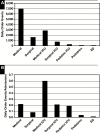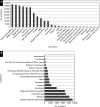Analysis of Daily Laboratory Orders at a Large Urban Academic Center: A Multifaceted Approach to Changing Test Ordering Patterns
- PMID: 28898984
- PMCID: PMC6322419
- DOI: 10.1093/ajcp/aqx054
Analysis of Daily Laboratory Orders at a Large Urban Academic Center: A Multifaceted Approach to Changing Test Ordering Patterns
Abstract
Objectives: We sought to address concerns regarding recurring inpatient laboratory test order practices (daily laboratory tests) through a multifaceted approach to changing ordering patterns.
Methods: We engaged in an interdepartmental collaboration to foster mindful test ordering through clinical policy creation, electronic clinical decision support, and continuous auditing and feedback.
Results: Annualized daily order volumes decreased from approximately 25,000 to 10,000 during a 33-month postintervention review. This represented a significant change from preintervention order volumes (95% confidence interval, 0.61-0.64; P < 10-16). Total inpatient test volumes were not affected.
Conclusions: Durable changes to inpatient order practices can be achieved through a collaborative approach to utilization management that includes shared responsibility for establishing clinical guidelines and electronic decision support. Our experience suggests auditing and continued feedback are additional crucial components to changing ordering behavior. Curtailing daily orders alone may not be a sufficient strategy to reduce in-laboratory costs.
Keywords: Clinical decision support; Daily laboratory orders; Utilization management.
© American Society for Clinical Pathology, 2017. All rights reserved. For permissions, please e-mail: journals.permissions@oup.com
Figures



Similar articles
-
Changing resident test ordering behavior: a multilevel intervention to decrease laboratory utilization at an academic medical center.Am J Med Qual. 2015 Jan-Feb;30(1):81-7. doi: 10.1177/1062860613517502. Epub 2014 Jan 17. Am J Med Qual. 2015. PMID: 24443317
-
Reducing Erythrocyte Sedimentation Rate Ordering: De-implementation and Diagnostic Stewardship.Hosp Pediatr. 2024 Aug 1;14(8):658-665. doi: 10.1542/hpeds.2023-007642. Hosp Pediatr. 2024. PMID: 38988307
-
Impact of weekly feedback on test ordering patterns.Am J Manag Care. 2015 Nov;21(11):763-8. Am J Manag Care. 2015. PMID: 26633250
-
Guideline-based decision support has a small, non-sustained effect on transthoracic echocardiography ordering frequency.BMJ Qual Saf. 2016 Jan;25(1):57-62. doi: 10.1136/bmjqs-2015-004284. Epub 2015 Sep 24. BMJ Qual Saf. 2016. PMID: 26405095 Review.
-
Laboratory test ordering in inpatient hospitals: a systematic review on the effects and features of clinical decision support systems.BMC Med Inform Decis Mak. 2021 Jan 18;21(1):20. doi: 10.1186/s12911-020-01384-8. BMC Med Inform Decis Mak. 2021. PMID: 33461548 Free PMC article.
Cited by
-
Leveraging informative missing data to learn about acute respiratory distress syndrome and mortality in long-term hospitalized COVID-19 patients throughout the years of the pandemic.AMIA Annu Symp Proc. 2024 Jan 11;2023:942-950. eCollection 2023. AMIA Annu Symp Proc. 2024. PMID: 38222425 Free PMC article.
-
Order Indication Solicitation to Assess Clinical Laboratory Test Utilization: D-Dimer Order Patterns as an Illustrative Case.J Pathol Inform. 2019 Dec 3;10:36. doi: 10.4103/jpi.jpi_46_19. eCollection 2019. J Pathol Inform. 2019. PMID: 31897353 Free PMC article.
-
Expert Recommendations on Frequency of Utilization of Common Laboratory Tests in Medical Inpatients: a Canadian Consensus Study.J Gen Intern Med. 2019 Dec;34(12):2786-2795. doi: 10.1007/s11606-019-05196-z. Epub 2019 Aug 5. J Gen Intern Med. 2019. PMID: 31385217 Free PMC article.
-
Association Between Health System Factors and Utilization of Routine Laboratory Tests in Clinical Teaching Units: a Cohort Analysis.J Gen Intern Med. 2022 May;37(6):1444-1449. doi: 10.1007/s11606-021-07063-2. Epub 2021 Aug 5. J Gen Intern Med. 2022. PMID: 34355347 Free PMC article.
-
Behavioral Economics Interventions in Clinical Decision Support Systems.Yearb Med Inform. 2018 Aug;27(1):114-121. doi: 10.1055/s-0038-1641221. Epub 2018 Aug 29. Yearb Med Inform. 2018. PMID: 30157514 Free PMC article.
References
-
- Huck A, Lewandrowski K. Utilization management in the clinical laboratory: an introduction and overview of the literature. Clin Chim Acta. 2014;427:111-117. - PubMed
-
- Elnenaei MO, Campbell SG, Thoni AJ et al. . An effective utilization management strategy by dual approach of influencing physician ordering and gate keeping. Clin Biochem. 2016;49:208-212. - PubMed
-
- Erlingsdóttir H, Jóhannesson A, Ásgeirsdóttir TL. Can physician laboratory-test requests be influenced by interventions? Scand J Clin Lab Invest. 2015;75:18-26. - PubMed
-
- Fryer AA, Smellie WS. Managing demand for laboratory tests: a laboratory toolkit. J Clin Pathol. 2013;66:62-72. - PubMed
MeSH terms
Grants and funding
LinkOut - more resources
Full Text Sources
Other Literature Sources
Medical

